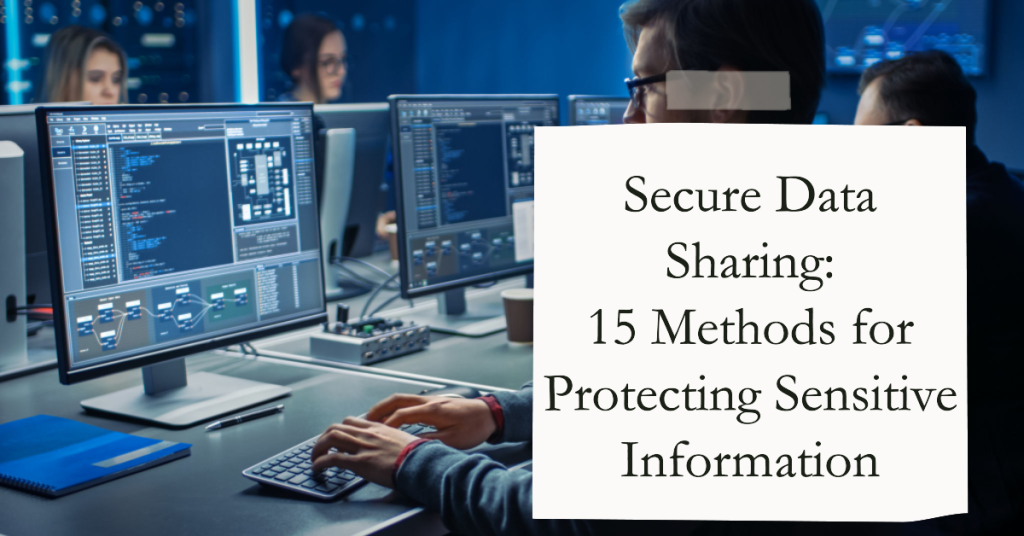
Secure data sharing has become a concern for everyone in today’s world. It’s vital to exchange information while also protecting sensitive data. This practice also safeguards valuable assets and ensures compliance with regulatory requirements.
In this article, we will explore various methods to protect sensitive information during data sharing. When individuals and organizations implement these methods, they can share data more securely. They can do it without compromising security or privacy.
Practical solutions such as encryption and access controls can be used. These methods will ensure the data’s confidentiality, integrity, and availability.
By applying these methods, you will gain valuable insights into how to share data. In today’s digital age, safeguarding sensitive information is of paramount importance. You’ll then be able to foster trust and confidence in data-sharing practices.
15 Methods for Protecting Sensitive Information
Safeguarding sensitive information is important in this digital age. Especially now where data breaches and unauthorized access pose significant risks. To safeguard sensitive information, it’s essential to use different methods and strategies.
Let us delve into 15 methods for protecting sensitive information:
- 1. Data Masking
Data masking is a process that replaces sensitive data with fabricated information. This is done during testing, development, and training. Data masking best practices shield the actual sensitive data. This allows you to work with representative data. This will also cut the risk of exposure.
- 2. Data Encryption
Encryption is an effective technique that uses special algorithms to scramble sensitive data. This makes the data unreadable without the corresponding decryption key. Encrypting your data ensures that unauthorized individuals who gain access won’t be able to make sense of the information.
- 3. Access Control
Limiting access to sensitive information is crucial. Access control mechanisms are designed to ensure that specific data is accessible only to authorized individuals. Such mechanisms include passwords, user roles, and permissions. This prevents unauthorized users from gaining access and potentially misusing sensitive information.
- 4. Physical Security
Protecting sensitive information physically is equally important. Implementing physical security measures prevents unauthorized physical access to sensitive data storage locations. Such methods include locked doors, security cameras, and security personnel.
- 5. Data Backup
Regularly creating backups of sensitive data is essential for its protection. Data backups enable you to restore information in case of breaches or deletions. It can also restore data when you accidentally delete your data or other unforeseen circumstances.
- 6. Data Governance
Establishing effective data governance practices is key to managing sensitive data. Data governance practices include policies and procedures. These rules regulate data access to sensitive information.
- 7. Strong Passwords and Multi-Factor Authentication
Using a strong password and using multi-factor authentication increases your account’s security. Your password should contain 12 characters long and should have a combination of upper and lower cases. Your password should also contain numbers and symbols.
Multi-factor authentication adds an extra layer of protection. It requires users to enter a code from their phone, in addition to their password.
- 8. Regular Software Updates
You should always keep your software up-to-date. Software updates often have security patches. This will reduce the risk of exploitation by malicious actors. Regularly updating your software ensures that you have the latest security measures in place.
- 9. Firewall Protection
Employing a firewall is essential for safeguarding your devices. Firewalls act as a barrier between your internal network and the external world. It prevents unauthorized access and filters out potentially harmful network traffic.
- 10. VPN Usage
When using public Wi-Fi networks, using a virtual private network (VPN) is highly recommended. A VPN encrypts your internet traffic and routes it through a secure server. It ensures that your data remains private and protected from eavesdroppers.
- 11. Identifying Sensitive Data
The data masking method is identifying the specific information that needs protection. This includes personally identifiable information (PII) like names, addresses, and Social Security numbers. It also includes other confidential data such as financial records and intellectual property.
By understanding which data requires protection, organizations can focus on securing the most sensitive information.
- 12. Selecting a Data Masking Technique
Various data masking techniques exist. Each of them has its advantages and drawbacks. Organizations must carefully choose a technique that aligns with the type of data being masked. They should also consider the desired level of security. Factors to consider include the complexity of the data and its performance considerations.
- 13. Masking the Data
Once the appropriate data masking technique is identified, masking the sensitive data begins. This involves applying the chosen technique to the data. Such techniques include replacing real values with random or fictitious ones. You can also alter the data in a way that renders it unidentifiable.
The goal is to keep the data usable for testing or development purposes. It should be done while preventing unauthorized access.
- 14. Testing the Masked Data
It is crucial to test the masked data to ensure its integrity for its intended purposes. This testing process involves running queries. It also involves utilizing masked data within software applications. Validating the masked data’s functionality can ensure that it retains its value. It also ensures that sensitive information is protected.
- 15. Maintaining the Masked Data
To sustain the security and effectiveness of masked data, regular maintenance is essential. This includes periodic updates or refreshing the masked data. This ensures its continued relevance and accuracy.
Additionally, encrypting the masked data can provide an extra layer of protection. This is an additional safeguard against potential breaches or unauthorized access.
Why Is It Important to Protect Your Sensitive Information?
Protecting your sensitive information is incredibly important for various reasons. Safeguarding your data ensures your privacy and prevents unauthorized access to confidential data. This includes sensitive details like your financial information and medical records. These private data should remain secure and only accessible to authorized individuals.
By safeguarding your sensitive information, you enhance your overall security. Unauthorized access to this data can lead to identity theft and fraud of information. It’s crucial to take proactive measures to prevent such risks. This can protect you from potential financial losses and reputation damage.
Compliance with regulations is another crucial aspect of protecting sensitive information. Many industries have specific policies like the Health Insurance Portability and Accountability Act. Complying with these regulations avoids legal consequences. It also demonstrates your commitment to ethical practices.
Conclusion
The importance of protecting sensitive information cannot be overstated. Safeguarding personal and confidential data is essential for preserving privacy. Preventing unauthorized access, and identity theft is also essential to preserve privacy.
Implementing effective data masking measures can ensure the confidentiality of sensitive information. Encryption, access controls, and physical security are other methods to protect sensitive information.
Compliance with regulations and industry standards further reinforces the commitment to data protection. Prioritizing the security of sensitive information fosters trust and maintains a positive reputation. You will confidently engage in data-sharing practices in our interconnected world.




Recent Comments